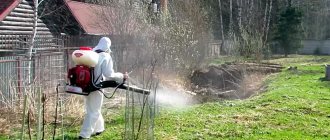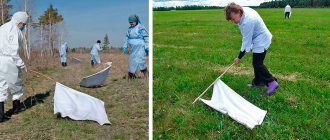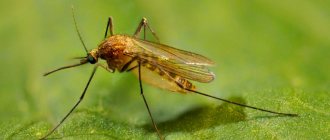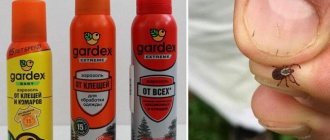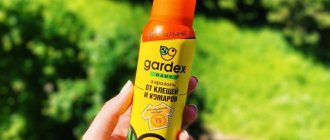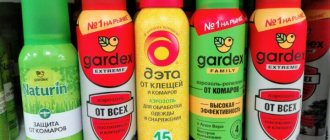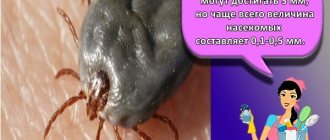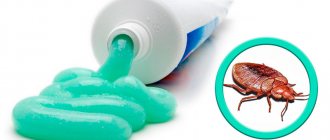Calculator
Calculate the cost of exterminating insects on the site
A garden plot is a natural habitat for ticks. It will not be possible to simply protect it from the encroachments of pests or scare them away. The only way you can win a war for territory against insects is to physically destroy them within the borders of your possessions. Regardless of how exactly you decide to get rid of ticks on your site, use all possible preventive measures against pests. They can be introduced and put into regular practice at any stage of the fight against parasites.
- Once a week, mow the lawn and dispose of the grass clippings; the shorter the vegetation, the less comfortable the environment for ticks.
- Cut and dispose of dried and rotten branches and wilted plants.
- Remove stored lumber and construction debris from the area, all of which provide an ideal haven for ticks and many other harmful garden insects.
- Around the veranda, gazebo, playground, swimming pool or any recreation area, create a protective contour 1 meter wide, covered with decorative gravel, the same can be done along the entire perimeter of the site.
- Use props for trailing flowers and shrubs to keep branches and shoots away from paths so they don't get bumped every time you walk by.
- Do not place hammocks, garden swings and deck chairs in damp or shaded areas of the property and/or close to dense vegetation.
The use of these recommendations makes the environment on the site much more uncomfortable for pests and safer for you, and also enhances the effectiveness of baiting ticks with the help of special preparations. By combining preventive protection and active pest control, you can make your site as safe as possible for the entire season.
note
If you are going to do an anti-tick treatment on an area, it should be prepared and cleaned before spraying.
If the area is completely overgrown with grass, it must first be mowed, removed, and only then the preparations must be sprayed. Direct treatment of the area against ticks can only be carried out using special means for baiting ticks. Any folk remedies, herbs and oils are ineffective against blood-sucking ticks on the site, if you want to reduce the risk of a bite to a minimum and get rid of pests, and not create the illusion of fighting them. You can poison parasites using insecticides yourself or order the appropriate service from the SES.
How to get rid of ticks in your summer cottage: methods and means
The only way to get rid of ticks in your summer cottage on your own is to carry out pest control yourself using special means. They are in concentrated form and require pre-mixing with water and preparation according to the instructions. The table below shows just a few of the products that you may find in retail stores and online; in fact, there is a much larger selection. You can choose any drug, having previously calculated the required volume for the area of your site.
| Product name | Volume/approximate price | Approximate area for the selected volume |
| Gardex Extreme Pliers | 50 ml/350 RUR | 10 acres |
| GET® (GET) against ticks | 250 ml/1,000 RUR | 6 acres |
| Kleschevit® Super | 100 ml/200 ₽ | 20 acres |
| Green Belt Protection of the area from ticks | 100 ml/200 ₽ | 20 acres |
| Medilis-Ziper | From 50ml/from 350 ₽ | 10 acres |
| Your farm Ixoder | 100 ml/400 ₽ | 20 acres |
| Guarantor against ticks | 50 ml/200 ₽ | 2 acres |
| Dr, Klaus against ticks, ants | 250 ml/300 ₽ | 6 acres |
| Cifox | 50 ml/300 ₽ | 5 acres |
| Bayer K-Otrin SK 50 | 1 liter/2,500 ₽ | 100 acres |
Prepared solutions for spraying an area against ticks are not stored, and it is also undesirable to drain their remains anywhere, so accurately calculate the required volume of insecticide for the area of your area. The instructions that come with each product will help with this.
note
If you are going to do an anti-tick treatment on an area, it should be prepared and cleaned before spraying.
If the area is completely overgrown with grass, it must first be mowed, removed, and only then the preparations must be sprayed. The drug, diluted in the required proportions, must be sprayed evenly over the area and left to soak for several days or hours - look for exact instructions in the instructions for the product you are using. Keep in mind that you will have to carry or move the sprayer around the entire site, so choose a device that you can accurately handle.
Helpful advice
Choose dry, windless weather for processing, with no prospect of precipitation in the next few days.
The optimal time to spray the drug is early morning or evening at sunset. Warn your neighbors in advance when and what time you are going to spray the area, give them the opportunity to protect themselves during this period. The ideal time for processing is the very beginning or end of the summer season, when the land is not yet or no longer covered with dense vegetation. At the same time, effective disinsection against ticks can be carried out at any time of the year - in early spring, mid-summer or late autumn. Areas with dense vegetation usually require a higher concentration of insecticide solution than areas where the grass is mown or there is exposed soil, gravel, tile, sand, decorative wood chips or the like.
Protecting yourself from mosquitoes
Although mosquitoes are not as dangerous to health as ticks, they are much more common, not only in rural areas, but even in large cities. If ticks attack during the day, then the incessant mosquito itch poisons us on charming summer evenings and does not allow us to sleep for many nights in a row. Let's consider what we can oppose to the hordes of flying and mournfully buzzing bloodsuckers.
Ointments, aerosols, sprays
The easiest way to temporarily protect yourself from mosquitoes is to repel insects from your skin by applying a special composition to exposed areas of your body. It usually has a pungent odor that is intolerable to insects.
Folk remedies contain essential oils of plants with a pungent odor - cloves, eucalyptus, lemon, anise, laurel, etc. They are harmless to the skin and respiratory organs, but, unfortunately, the validity period of such products is short - no more than half an hour, after which they should be renewed. The most effective of them are essential oils of wormwood, orange, as well as fir, cedar and other conifers. They are applied not only to the skin, but also to window frames and door frames.
Commercially produced chemicals contain diethyltoluolamide or cypermethrin. They work for several hours, but if accidentally ingested, they irritate the mucous membranes of the eyes, mouth or nose. Those. If you scratch your nose with the hand on which the drug is applied, you will experience very unpleasant sensations. Children and pregnant women are strictly prohibited from using such compounds.
Barrier means
There are time-tested, simple and reliable means for protecting premises from mosquitoes and midges. The simplest of them is a mosquito net. It is installed on a door or window opening to prevent flying insects from entering. The mesh fits tightly to the edges of the opening, and the cut in the middle is equipped with a magnetic lock that securely closes the edges after a person passes through the door.
Barrier means also include special mosquito repellent clothing. It is sewn from a fine mesh material that allows air to pass through perfectly, but leaves the skin inaccessible to flying bloodsuckers. It is good to walk in the forest in such clothes: the summer heat is not felt at all thanks to excellent ventilation, but mosquitoes do not bother you.
Mosquito insecticide for treating areas and water bodies Mosquito eater 100ml
Mosquito traps
If there are not too many insects, then various traps are an effective means of combating them. A budget option is a homemade structure made from a plastic bottle into which sweetened water with added yeast is poured. First, the bottle is cut in half and the upper part, neck down, is lowered into the lower part, but so that the neck does not touch the water. Attracted by the yeast smell, mosquitoes fly into a narrow hole and die, suffocating in carbon dioxide produced by yeast from sugar dissolved in water.
Not everyone is attracted by the prospect of constantly smelling the specific aroma of fermented yeast in the house. A much more pleasant and aesthetic trap is an ultraviolet lamp, which can be placed not only indoors, but also on the veranda or gazebo. Attracted by the ultraviolet glow, mosquitoes land on the lamp and are killed by weak electrical discharges. The ultraviolet radiation emitted by special LEDs is harmless to human eyes, but attracts mosquitoes like a magnet. The voltage on the electrodes is enough to kill a mosquito, but not enough for a fly or butterfly. A person who accidentally touches the electrode will only feel a weak prick.
Mosquito lamp Era ultraviolet 6W
Fumigators
Perhaps the most popular means for getting rid of flying bloodsuckers today remain fumigators - a large family of products whose action is based on the evaporation of an insecticide. Most often, allethrin is used for this, which is impregnated with cardboard plates or poured into a special bottle with an evaporation rod. The concentration of poison in the air is small, but for mosquitoes it is fatal or at least stunning. A fumigation coil has become a popular means of killing insects outdoors. It is hung on a holder and set on fire, after which the spiral smolders for several hours, evaporating the active substance.
Destroyers
For those who are willing to pay no price for a relaxing holiday in the countryside, today there is an extremely effective device - a propane-powered mosquito killer. Once turned on, it begins to radiate mild heat into the space and evaporate a chemical attractant that imitates the smell of sweat. In addition, a dim UV light is turned on. Attracted by all this, mosquitoes flock to the exterminator, enter the air flow and are sucked inside, where they die. The device almost completely eliminates mosquitoes from the area. The only drawback is the rather high cost, which prevents the widespread distribution of the device.
Mosquito candle in a pot 7.7x6.3cm paraffin/wax
Plants on the site
Some plants have an odor that mosquitoes cannot tolerate. By planting them around the veranda, gazebo or other place where you like to spend time, you can get rid of annoying insects or at least significantly reduce their number. This magical property is possessed, for example, by the Manchurian walnut - a beautiful spreading tree that grows up to 20 meters in height and provides dense shade. Along the fence you can plant bushes of beautiful bird cherry, which has a similar effect on mosquitoes, flies and other flying pests.
But trees and shrubs grow slowly. To get quick results, plant marigolds, basil, mint with lemon balm, wormwood and other aromatic herbs on your plot. Not only will they freshen the air and create an amazing cocktail of smells, but they will also repel many harmful insects from your garden.
The listed methods can significantly reduce the number of blood-sucking insects and provide you with a pleasant, relaxing holiday at the dacha, recreation center, country house or during a picnic in the lap of nature.
How to get rid of ticks in the countryside using SES
Organizing and carrying out anti-tick treatment independently is a fairly capital and lengthy process. Ordering the processing of a site at the SES allows you to simplify and speed up the process. Professional disinfestation or decontamination is the most effective way to get rid of ticks in your dacha with a minimum of effort.
- Processing of standard plots of 6–20 acres is done in 1 day.
- The use of special spraying equipment - motorized guns and expert-level means makes professional pest control especially effective.
- The preparations used do not harm the garden and are safe for the soil.
- You receive a guarantee for the service for the entire season.
- Processing is carried out under an official contract, which sets out the circumstances of the provision of the service, the conditions and terms of the guarantee.
SES "Des Group" has been treating summer cottages from blood-sucking ticks, other types of garden pests and hogweed since 2014. You can order the service urgently or schedule it for any date convenient for you in the near future. The cost of treatment will depend on the area of the site.
| Treatment of the territory | Processing cost |
| Area up to 10 acres | From 5,500 ₽ |
| Area from 11 to 30 acres | From 6,500 ₽ |
| Area from 31 to 50 acres | From 7,500 ₽ |
| Area from 51 to 80 acres | From 12,000 ₽ |
| Area from 81 to 100 acres | From 15,000 ₽ |
| Area more than 100 acres | Negotiable |
You can find out the price of treating an area against ticks and ask other questions you are interested in on the topic by calling SES “Des Group”, dialing the number yourself or ordering a free call back from the operator through the contact form on the website.
Folk methods of struggle
If you want to do without chemicals completely, then it is better to use proven folk remedies. Experienced summer residents recommend the following:
- Irrigation of the area with solutions of essential oils. In particular, rosemary and mint. It turns out that the tick does not tolerate these odors. It is enough to add 5-10 drops of oil to water and spray it on garden crops.
- Citrus juice. It also works well as a bloodsucker remedy. Moreover, you can use both fresh juice and aromatic oils of orange, tangerine, and lemon for irrigation.
- Boric acid or soda. These products need to be sprinkled in places where ticks accumulate to get rid of them.
- Infusion of wormwood. Here you need to take 2 kg of chopped grass and pour moderately hot water (10 liters) for two days. After this, the infusion is boiled for half an hour. All that remains is to bring the decoction again with cold water to a volume of 10 liters. The finished product is diluted with clean water in a ratio of 1: 2 and the area is sprayed. Using the same principle, you can prepare infusions of geranium or sage. They also repel ticks.
- Garlic infusion. To prepare it, add two liters of water to four heads of garlic. Infuse the solution for 5 days in a dark and cool place. Before irrigating the area, the product is diluted with water in a 1:1 ratio.
- Cyclamen roots. An infusion is prepared from them according to this recipe - 100 grams of tubers are poured into 1 liter of boiling water. Now cook the roots until they are completely cooked until they soften. The finished product is cooled and strained. The area is sprayed with the decoction.
- You can also plant natural insecticides around the perimeter. These are chamomile, wild rosemary, tansy, bird cherry. They repel the bloodsucker and prevent it from entering the area.
Advice: in order to protect the territory as much as possible from tick invasion, it is advisable to team up with your neighbors and carry out simultaneous treatment of two or more areas. It is advisable to take the family to the dacha no earlier than 4-6 days after baiting the insect.
Interesting: Wasp nest: instructions for getting rid of it
Where do ticks come from in the country?
As mentioned above, a garden plot is a natural habitat for blood-sucking ticks and, most likely, they have always lived in this area. The effect of the sudden appearance of mites may be associated with their activity, and not with the very fact of the presence or absence of pests.
Ticks are everywhere, in absolutely all areas of Moscow and surrounding regions, but they become most active at temperatures around + 18 degrees Celsius and high humidity. The ideal weather for them is warm days with periodic short-term rain and sun.
Recommended Links
Tick map: dangerous regions of Russia and areas of the Moscow region.
Weather trends may vary between seasons and thus influence tick activity. In a dry summer, you may get the feeling that they have disappeared; in a warm and rainy summer, you may feel like there has been an invasion. You can predict tick activity in your area using a local weather forecast based on temperature and humidity levels.
Also, the number of ticks can be influenced by the general climatic features of specific areas and the topography at the location of your site. The northern regions of the Moscow Region are traditionally cooler and wetter than the southern ones, and tick activity in them is usually higher than in the south. In areas in lowlands, near lakes, swamps and deciduous forests, there may be more pests due to the abundance of shaded and wet areas. In dry areas at higher elevations, near coniferous forests, in flat areas that are abundantly illuminated by the sun, there will be fewer parasites due to lack of moisture and heat.
How to look for ticks on your property
To understand whether there are ticks in your area, and to roughly estimate how many there are, you need to conduct an experiment.
- Take a piece of white cloth, a rag, a piece of an old sheet, a piece of tarpaulin - any light-colored fabric the size of a kitchen towel will do.
- Run the cloth over bushes, tall grass, and soil in several areas of the site.
- After each test, inspect the fabric - pests will remain on it; by their number, you can roughly judge the scale of the problem with mites in the area.
Professional pest control uses a similar method for diagnosing the number of ticks in an area. Specialists attach the white material to a special bar. You can use a regular stick for this purpose. As a result, you will have an analogue of a flag, which can be carried through the bushes from a safe distance, without having to climb into them with your whole body.
Biological drugs
If there are children on the site, aggressive chemicals are contraindicated. Here you can get by with no less effective, but at the same time relatively safe biological drugs. These have proven themselves well:
- Apollo;
- Fitoverm;
- Aktofit;
- Vermitek.
Unlike chemicals, biological compounds can be used during the flowering or fruiting period of plants. Most drugs are resistant to rain. But here the tick does not die immediately after treatment, but within 3-5 days.
Why are ticks dangerous in a summer cottage?
Ticks are dangerous in a summer cottage because they can bite people and pets and thus infect them with various blood-borne diseases. These include:
- Tick-borne encephalitis
- Borreliosis
- Monocytic ehrlichiosis
- Granulocytic anaplasmosis
Without timely detection and treatment, these diseases can lead to serious health consequences, including death, in both people and pets, especially dogs.
Recommended Links
Encephalitis in dogs: what is dangerous, symptoms, methods of protection, vaccinations.
How to remove an embedded tick and what to do next
You can remove the tick either yourself or by going to the emergency room of the medical facility closest to you at the time of the bite. If you are going to remove the tick yourself:
- Wear disposable gloves, take a cotton pad or gauze folded in several layers - something that will prevent direct contact of the skin of your fingers with the insect.
- Grab the tick as close to the surface of the skin as possible and twist it out, carefully but confidently, without making sudden movements, it doesn’t matter which direction you twist it.
- The wound must be disinfected immediately; for example, hydrogen peroxide is suitable for this purpose.
- The removed tick should be placed in some container, ideally in a special container for testing, and a piece of cloth slightly moistened in water should be added to it so that it does not suffocate while you are taking the pest for analysis.
To remove ticks, you can use tweezers or a special tick remover, which you can buy at a pharmacy or online. It is also advisable to store several containers for analysis in case of a bite at the dacha; they do not take up much space, are compact and convenient for transporting pests.
At the emergency room, a nurse will remove the tick and you can take it with you to get tested yourself. Analysis of ticks for infection is carried out everywhere for a fee. It should be done immediately after you have removed the parasite, preferably on the same day or the next day. You can contact:
- To the Center for Hygiene and Epidemiology in Moscow.
- Center for Hygiene and Epidemiology in the Moscow Region.
- To a commercial laboratory - Hemotest, Invitro, etc.
Taking a tick for analysis after a bite is necessary in order to immediately determine whether it has infected you with something or not, even before the first symptoms appear. The sooner you start treatment, the easier it will be to cope with the disease and the sooner you will recover.
What to do if a tick bites a child
If a child is bitten by a tick, it is necessary to carry out the same steps as for adults. Make sure to submit the tick for examination.
Monitor your child's well-being for the first 3 weeks after suction. Any deviation in the child’s health should be alarming; in such cases, the child is immediately shown to a doctor.
In addition, for preventive purposes, children are given free anti-tick immunoglobulin at a medical institution at the rate of 0.1 ml per 1 kg of child weight. The introduction of immunoglobulin provides protection for the first time, since ready-made antibodies are introduced. In the future, if there is a threat of ticks being sucked on again, it is better to undergo a course of preventive vaccinations. Vaccinations in endemic areas are carried out from the age of three.
